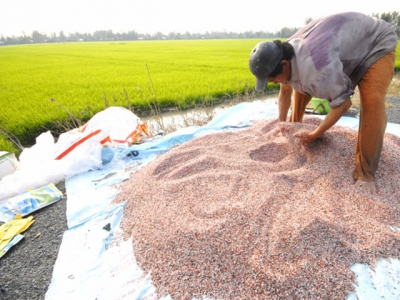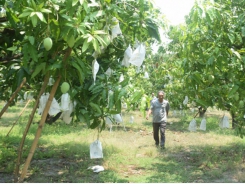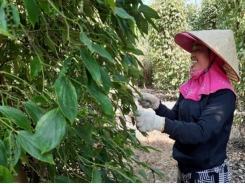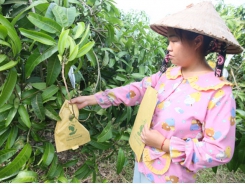When water source for agriculture burdened with series of contamination

Agriculture production has resulted in a range of negative consequences that contribute to environmental contamination, most notably water pollution. This is a heated topic in a number of provinces.
A huge amount of fertilizer remains in the soil when the plants are incapable of absorbing it all. Photo: LHV.
Waste and environmental risk associated with fertilizer and pesticide abuse
According to World Bank figures from 2017, Vietnam uses 2.5-3 million tons of inorganic fertilizer yearly to cover about 7 million hectares of land. While plants are capable of absorbing between 30.5 to 50% of the nutrients applied. The quantity of unconsumable residues is enormous.
Additionally, fertilizer waste degrades agricultural products, soil quality, pollutes water sources, and increases greenhouse gas emissions, all of which hurt the environment.
According to MARD's study on agricultural and rural environmental protection in 2020, the majority of local authorities and farmers in the Mekong Delta stated that agricultural environmental pollution was caused by increasing intensive farming, expansion of production area, and a focus on output.
Fertilizer expenses account for about 30% of overall production costs. There is a USD 130 million yearly loss owing to 865,000 tons of chemical fertilizer wastes released into the environment as crops are unable to absorb.
Local data indicate that the majority of river systems providing water for agriculture in provinces and the basin system have a high level of organic and microbiological contamination. Additionally, plastic trash left on fields during harvesting and other human activities has had a substantial impact on canal system flow, resulting in microplastic contamination of agricultural goods, soil, and water resources. water.
Additionally, non-compliance with the isolation period following spraying, the practice of indiscriminately discarding chemical and pesticide packaging after use, and the habit of washing pump bottles and chemical preparation tools in inappropriate locations contribute to pollution of water, air, and ecosystems.
Pesticide and chemical fertilizer use also wreak havoc on the environment in a variety of ways, including rainwater overflowing through degraded storage facilities, drug residue left in bottles being thrown into ponds, lakes, and rivers, and excess drug from overdosing seeping into the soil...; all while affecting beneficial organisms in the environment and increasing harmful organisms, contaminating the soil and posing a high risk of residues in a contaminated environment.
Around 60 million tons of garbage from agriculture are generated annually
According to the Institute of Agricultural Environment's (2020) estimates based on statistical data and surveys in several provinces, the amount of solid waste generated during the livestock production process is estimated at 60.18 million tons, including 34 million tons of waste from cows, 10 million tons from poultry production, and 7.6 million tons from pig production. The quantity of solid waste generated by animals in 2020 is more than in 2019 and 2018 owing to the pig herd's recovery at a time when the buffalo herd grows.
According to various research conducted in Vietnam, the average coefficient of wastewater generation from livestock production is around 12.5 liters/day for buffalo and cows and approximately 20 liters/day for pigs. According to the National Environmental Status Report (2018), up to 6.66 million m3/day of wastewater is created.
When untreated animal manure is released into the environment, it pollutes the surface and groundwater, soil, and air, posing a major threat to human health.
The coliform levels in wastewater from livestock farming regions are very high, even exceeding the accepted limits sometimes.
Additionally, since household livestock production continues to account for a significant amount of output in certain areas, the treatment and management of animal waste are becoming increasingly complex.
Additionally, only 10% of families have hygienic animal barns, and only 0.6 percent of households have environmental commitments. Around 23% of livestock families do not handle waste in any way and instead release it straight into the environment.
Additionally, livestock waste, particularly in epidemic regions, includes a variety of dangerous bacteria such as ecoli, salmonella, worms, disease-causing flukes, and viruses, will have a significant impact on public health, create disease outbreaks in animals, significantly contaminate the landfill area, and harm human health.
For seafood, water pollution is mostly caused by residual organic pollutants, which are leftovers from feed, manure, and other wastes that are deposited at the pond's bottom.
Additionally, pesticides and antibiotics used in crops are not handled. Aquaculture wastewater and sludge including food remnants are seen as a significant environmental concern.
Wastewater, with a volume of 3.6 billion m3/year, is a significant environmental issue in aquaculture locations, particularly in very intensive farming areas, excluding cage farming sites.
Sludge is also regarded as a severe environmental hazard in many aquaculture locales because to its vast volume and origin as the deposition of surplus feed, aquaculture item excrement, and a source of disease transmission in aquatic animals.
To mitigate agricultural water contamination
To ensure sustainable agricultural growth, it is vital to have methods for agricultural water pollution management.
To begin, it is required to convert and implement farming, breeding, and aquaculture technologies economically and logically to decrease the quantity of contaminated wastewater that must be cleansed and rigorously managed.
Second, it is required to publicly propose wastewater treatment with biogas, with an emphasis on aquaculture production planning; to engage in scientific research on animal husbandry, farming, and clean production technologies.
Thirdly, it is critical to strictly supervise the usage, acquisition, and sale of agricultural chemicals such as fertilizers and pesticides, as well as to arrange the collection and treatment of solid and hazardous wastes, to limit the effect on the aquatic environment.
Fourth, the development of surface water protection zones inside farms or buffer zones surrounding farms is an effective method for preventing pollutant movement and spread in water sources.
Finally, strengthen propaganda and dissemination of legal documents and enforcement of environmental protection sanctions in agriculture and rural areas; increase awareness of the roles and responsibilities of all levels, each citizen, and community in protecting the agricultural and rural environment, particularly with regards to wastewater.
Related news
Tools

Phối trộn thức ăn chăn nuôi

Pha dung dịch thủy canh

Định mức cho tôm ăn

Phối trộn phân bón NPK

Xác định tỷ lệ tôm sống

Chuyển đổi đơn vị phân bón

Xác định công suất sục khí

Chuyển đổi đơn vị tôm

Tính diện tích nhà kính

Tính thể tích ao




 Vietnam pushes up exporting coffee to China
Vietnam pushes up exporting coffee to China  High income with Thai jackfruit and Taiwanese mango…
High income with Thai jackfruit and Taiwanese mango…